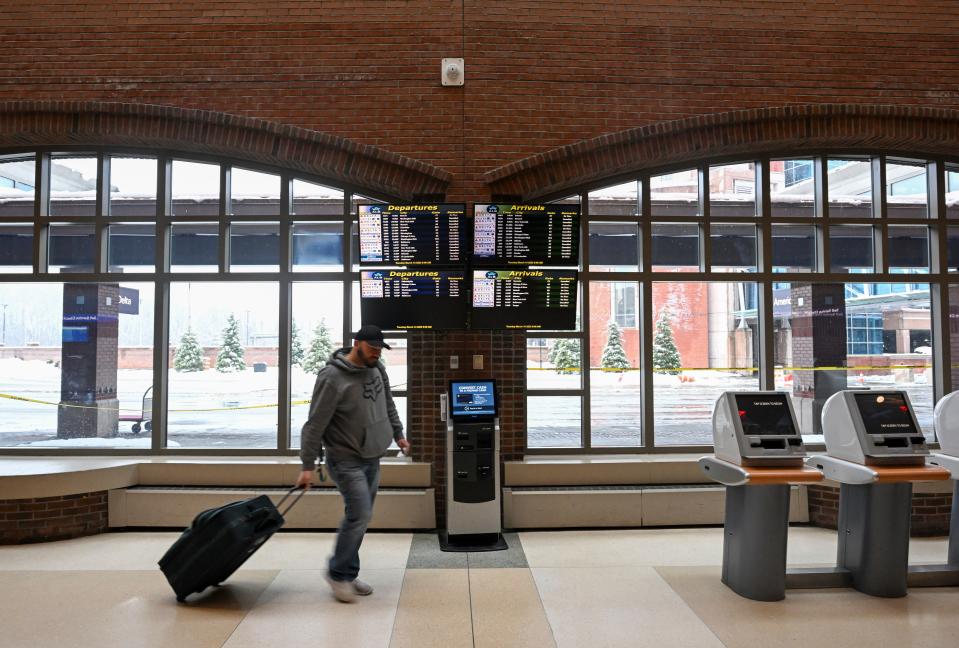Know before you go: These 5 US airports have the most flight disruptions
We've gotten to the point where 3 in 4 Americans have concerns about flying lately, according to the travel booking app Hopper.
It makes sense, especially after December's Southwest Airlines chaos that left thousands of people and their bags stranded (sometimes in different locations). Even earlier this week, more than 4,300 U.S. flights were delayed and 1,100 were canceled because of late winter weather.
The good news is that there are fewer disruptions this year for U.S. fliers. From Feb. 10 to March 10, about 1,300 fewer flights were canceled compared with the same dates in 2022, Hopper found.
"In the past year, flight disruptions have improved – and we're seeing fewer cancellations and delays," said Hayley Berg, lead economist for Hopper. "This year, airlines are operating more efficiently, with higher staffing and more conservative schedules. Though we likely will see continued cancellations and delays, we expect to see fewer mass disruptions caused by events other than bad weather."
The year-to-date on-time arrival rate for U.S. airlines was 76.7%, according to the Department of Transportation.
What do I do if my flight is canceled? 'Your multitasking skills need to come through'
What's behind the disruptions? Let's be honest, air travel has been a gamble.

What are the US airports with the most flight disruptions?
With spring break just around the corner, and soon after that the summer travel season, Americans with upcoming flights may be wondering if the airport they're departing from is prone to delays and cancellations.
AirHelp, a claims management company focusing on passenger rights, looked at data from a variety of sources, such as reports from airlines, airports and air traffic control systems, to determine which major U.S. airports had the worst flight disruptions, which are delays of at least 15 minutes or cancellations, during February 2023.
Below are the results:
Kahului Airport in Hawaii (OGG): 30.82% of flights disrupted.
Reno-Tahoe International Airport in Nevada (RNO): 29.15% of flights disrupted.
Harry Reid International Airport in Nevada (LAS): 28.52% of flights disrupted.
Dallas/Fort Worth International Airport in Texas (DFW): 28.51% of flights disrupted.
Logan International Airport in Massachusetts (BOS): 28.23% of flights disrupted.
Dallas was found to be home to the two airports with the most cancellations in February: Dallas Love Field, which had 4.85% of flights canceled, and Dallas/Fort Worth International, which had 4.6%.
As for the most reliable airport? McGhee Tyson Airport outside Knoxville had more than 85% of its February flights depart on time.
Why do these airports have the most disruptions?
"There are a lot of reasons why airports experience a spike in disruptions, but many include factors often outside of an airport’s control," said Tomasz Pawliszyn, CEO of AirHelp. One of the most common causes of flight disruptions is congestion in the air and not having slotted backup flights, which can have a ripple effect on the following flights, he said.
Another is staffing, because the industry is still working to build to pre-pandemic capacity. "Areas that have high tourism-to-local population ratios like Maui often face staffing challenges," he said. "It's difficult finding backup options to service the needs of travelers passing through when the industry at large is facing staffing shortages and still rebuilding from the pandemic, but demand is really high."

Inclement weather can also place "extreme stress" on airports if employees can't make it to the airport and planes aren't cleared for takeoff.
That doesn't mean you should avoid these airports completely, because the list tends to fluctuate. "One month may be impacted by weather, increased travel demand, or a pilot strike," Pawliszyn said.
This summer, as people flock to warm-weather destinations, will change up the list as well, he expects.
What should you do if your flight is delayed or canceled?
"When your flight is canceled, delayed or overbooked, it's important to make sure you understand your rights and when you are owed compensation – which can depend on the departure location and airline," he said.
By federal law, airlines have to offer refunds if a flight is canceled for any reason. But it's always a good idea to see your airline's policy, because factors such as rebooking time frames or other things up for compensation varies.
What to do if your flight is canceled: 'Your multitasking skills need to come through'
As for delayed flights, it is up to the airline's discretion because they aren't required to offer reimbursement for delays outside their control, like bad weather. Some airlines, like Delta, will give free meal vouchers for delays over three hours and free hotel accommodations if a flight isn't available until the next day.
The Department of Transportation's interactive dashboard, which launched this year, makes it easier for passengers to see what airlines will offer for a significantly delayed or canceled flight.
Kathleen Wong is a travel reporter for USA TODAY based in Hawaii. You can reach her at kwong@usatoday.com
This article originally appeared on USA TODAY: Spring break travel: Airports with most flight delays, cancellations

